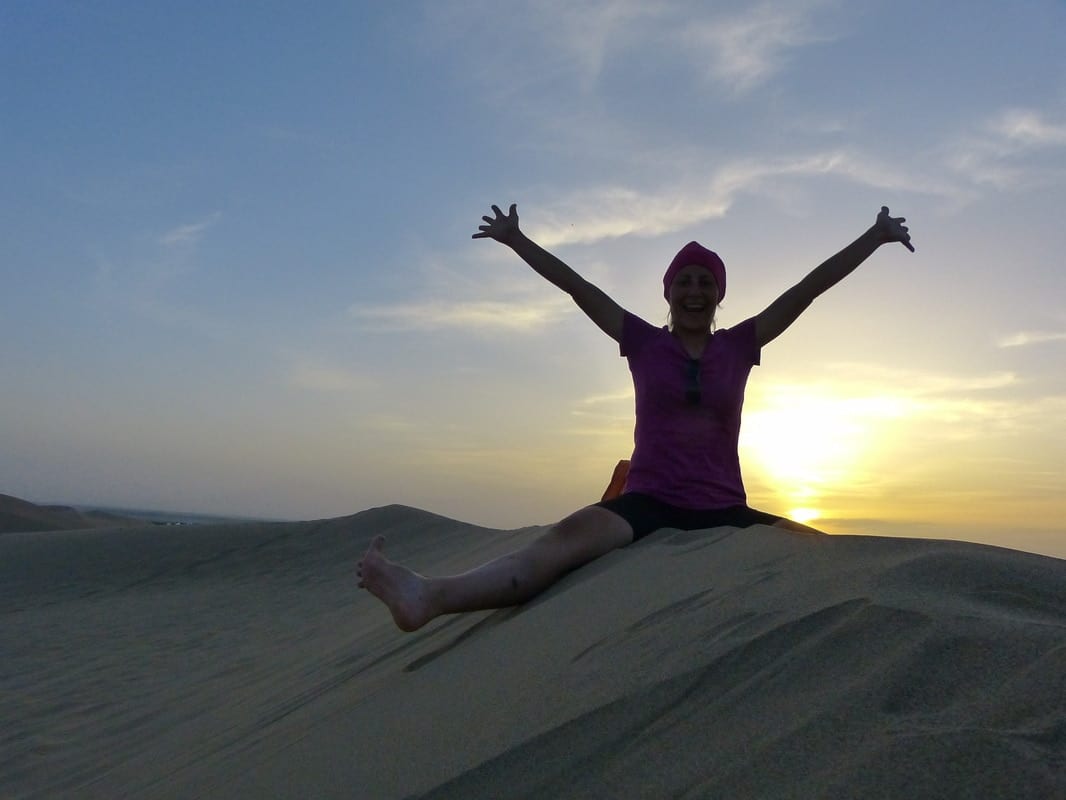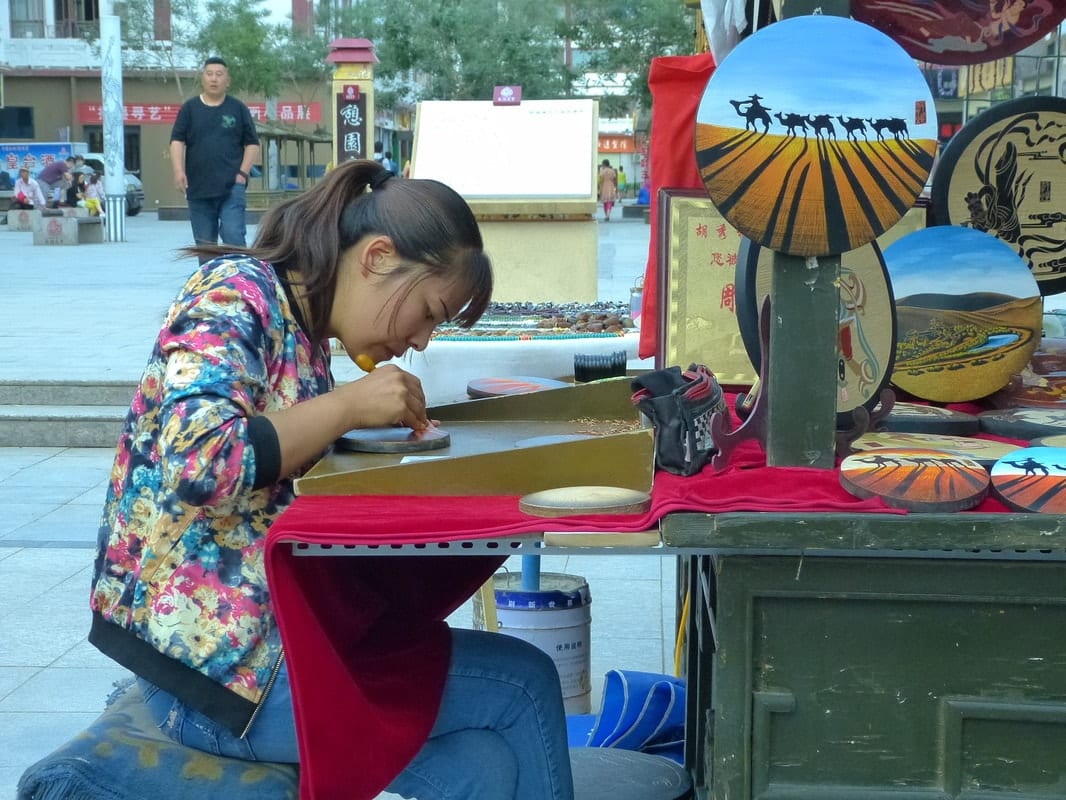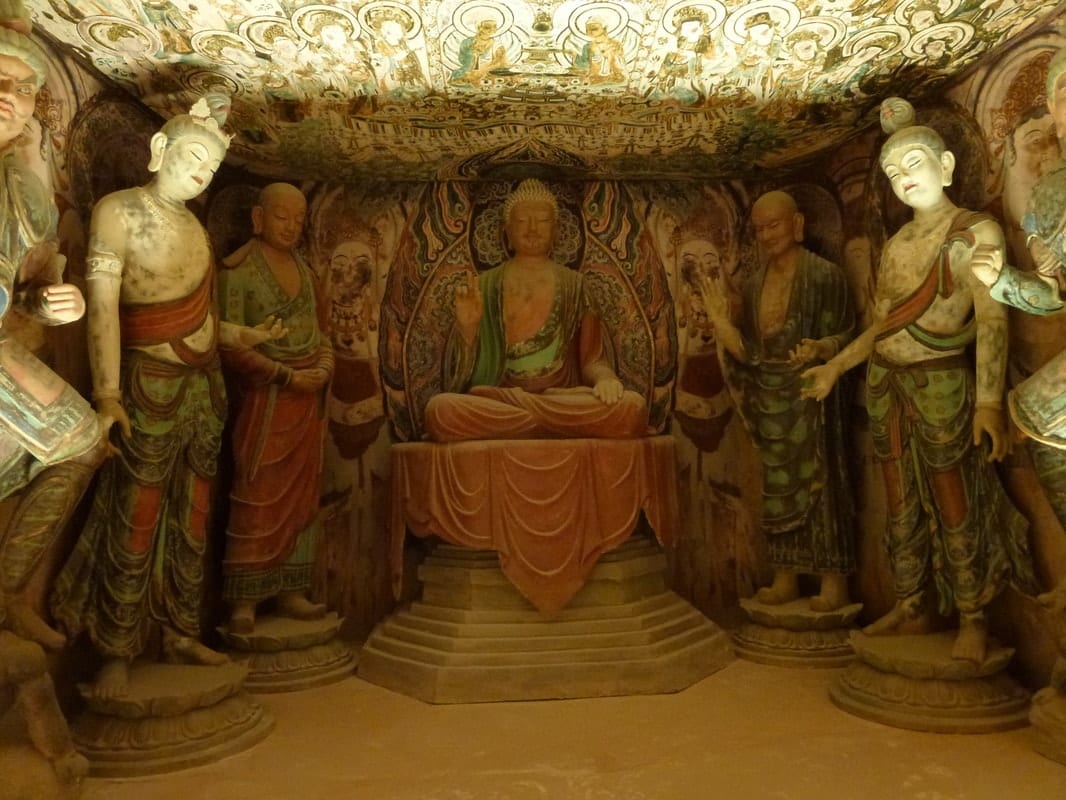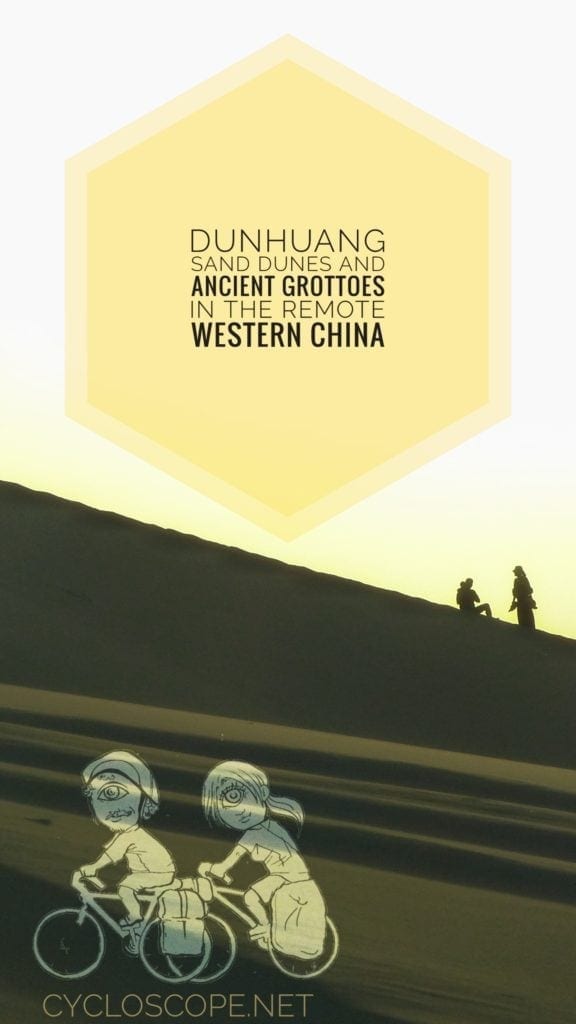Last Updated on 27 June 2022 by Cycloscope

The spectacular deserts of Gansu, Western China, A visit to the famous Mogao Caves and a useful. Hack to enjoy the biggest sand dunes in China for free!
Dunhuang is probably the most touristic destination in Western China. The main attractions are for sure the Mogao Caves and the huge sand dunes around the Crescent Moon Lake.
The Mogao caves are one of the most valuable heritage of the world, comparable to the Sistine Chapel or the ruins of Angkor; frescoed grottoes perfectly preserved, showing 1000 years of Buddhist art’s evolution.
The Crescent Moon Lake (Yueyaquan) itself, is a bit of an overrated attraction, with a ridicolous entrance fee. The dunes of Dunhuang though, are spectacular, probably the best sand dunes in China, and a mong the most beautiful in the world. In this article, we’ll explain how to get to the Dunhuang Sand Dunes for free.
Beside this famous sights, there are many more small things to see in Dunhuang, and the town itself is worthy a few days stay. It’s a pleasant small city, another oasis in between two deserts, the Taklamakan and the Gobi Desert. Another Silk Road caravanserai.
The road from Turpan to Dunhuang
Turpan bus station, heading to Dunhuang (wiki). I get into a bank thinking it’s the ticket office, and thus we get the really friendly help of an employee, who speaks some English and comes with us to the real ticket office.
To put the bicycle in the trunk of the bus you have to pay a small bribe, to be divided by the driver and the baggage desk lady. The task itself is not easy, there’s no space and there are two more Chinese cyclists.
But fortunately the passengers are few, I think about ten, and we get more room to sleep. The bus is slow and pretty boring and we get three passport controls.
XinJang people’s mobility it’s quite restricted, especially if you’re ethnic Uyghur you’re sure you’re gonna be checked often. Indeed there’s a man with a Taqiyah (typical Muslim hat) and beard that gets some problems.
From the bus we also see police practicing martial arts in the police station courtyard, weird.

We were supposed to arrive around 8 am, but it’s past 11 when we get in Dunhuang (wiki). So we crossed from Xinjiang into Gansu however, happy to have saved a bike ride that, else than the spectacular enough Flaming Mountains just outside Turpan, it’s on a dusty road into the same bare rocky desert, dotted with scattered smoking, stinky factories.
Of course, if we had had an unlimited visa for China it would not be too bad to save on the cheap bus, but with only one month would be a waste to see just grey rocks.
Put the bikes in one piece again (we had to dismantle them a bit to get in the bus) we go looking for a place to sleep.
Plenty of choice here, we find a hotel for 60 yuan (9€). A big double room, with huge TV, kettle, bathroom with shower, slippers. toothbrush, soap, shampoo and telephone… not bad really. Something to eat at the restaurant across the street, and just before sunset, the best time, we go to look at the famous sand dunes.
Dunhuang sand dunes

About 6 km south from the city center there’s the official entrance to the dunes and the so-called Crescent Moon Lake, a small lake in the desert that indeed has the shape of a crescent moon. Of course, the whole thing is fenced and the entry fee is 160 yuan (23€… insane). But the dunes stretch east and west and we think there must be a way to get on them for free. And we find it!
How to enter for free at the Dunhuang sand dunes:
Take the last road to the right before the official entrance gate, you will pass a nice little village where the inhabitants breed camels (now only for tourists, we think), the dunes are on the left side behind some nice vineyards, but still fenced here.
Keep on riding, following the same direction (west) for about 6/7 km, until you’ll see a sand expanse on your left, there’s a little creek there. So here there’s no more fence and you’re free to climb the huge dunes and get lost in the desert!
Really fun getting to the top and slide like a kid, or just enjoy the sunset view if you’re more a romantic type (we had done both). Finally, we get some good feeling from the Gobi, a sensation that traces more the stereotype that everybody has of a desert.
The dunes are gorgeous, hundreds meter high and with thin golden sand that is a pleasure under your feet. You will not see the lake though, but the nice thing are the dunes. Moreover, the girl from our hotel told us that probably the lake could by dry at this time of the year.
Dunhuang city center, food square and night market

We go back to the happy Five Ring Hotel, we sleep in our huge double bed after zapping between documentaries and Chinese talent show.
The day after we visit the town center, very pleasant, with the famous night market where local handicrafts are sold, together with crappy souvenirs.
Then we stroll through the “grill district” (plenty of shashlik and grilled fish here), and what we liked more, the sheltered “food square“, with dozen tiny restaurants each one specialized in a single type of dish. We visit it two times getting first a hot-pot casserole (I with donkey meat, typical from this area, and Elena with vegetables) and then North Korean cold noodles, of a weird violet color.
Mogao Caves

On June 15, we are ready to go to the Mogao Caves, a complex of 492 Buddhist grottoes carved in a sandy cliff, spanning 1000 years of history and Buddhist art, through four dynasties. Magao Caves are considered one of the most important cultural and artistic relic of the whole China, and thus of the whole world.
The site should be, according to OpenStreetMap, about 20 kilometers and instead after ten we find the ticket office and the road is closed. They tell us that the ticket doesn’t cost 120 yuan (17€) anymore, from this month (June 2015) the entry fee raised to 240 yuan (34€, but with guide included).
To see the caves we are obliged to visit this new building, the audiovisual center, where we have to put up with not one but two films that will spoil us the caves before we see those live. Brilliant! The problem is just that we don’t have all this money. We could give up seeing the caves or remain here until the money from our tenant will come from “Belpaese”. We decide to stay, I don’t think we’ll never have another chance to see this marvel.
A struggle with the Chinese tourism bureaucracy

The first movie lasts 30 minutes and is not bad, traces the birth of the town of Dunhuang on the Silk Road and the making of the caves. The second is in another room, with a 360° screen and, as we feared, shows the caves we’re going to visit spoiling the surprise. Half of the visitors sleep in the comfortable chair. Chinese people don’t complain, if it’s mandatory it’s mandatory. Well done Mao.
Then, we have to wait 3 hours to tour with an English-speaking guide. The guide is a must have, the caves are closed by gates and they have the keys, and of course is useful to have someone explaining something to you. There are no explanatory signs. And anyway is mandatory. We find out later that the guide was there from 9 am, but foreigners can have the guidance only at certain times, set by the Communist-issimo bureau of tourist administration of Gansu region.
To reach the caves from the audiovisual center you have to take a bus, all included in the ticket, cause with your legs you can not go anywhere. Chinese tourists are absurd, always run and push. But people are numbered and the buses can accommodate them all, useless to push. Even when they visit the place they run, seem to be always in a hurry. Probably they are on organized trips and have to rush to see more things possible.
However, our guide will pick up us at the entrance and save us the cue, with us there’s also an Australian dude.

Being only the 3 of us with the guide is just perfect. Having her the keys of the caves we can go to those where there is no crowd. The caves are indeed closed with gates to protect them from weathering.
We see 12 caves in little more than 2 hours, from different periods and with very different styles, including the famous library cave, where hundreds of precious manuscript were discovered in 1900, one of the most important archaeological finds in the last century.
The frescoes are all original and perfectly preserved, the pigments were made from the most precious raw materials, blue from topaz, red from ruby, and so on.
The statues, however, are sometimes original sometimes reproduced or re-painted, mostly over the XIX century. But the art is astonishing however, those caves were sponsored by the most wealthy and powerful families of the whole Chinese empire, willing for divine blessing and/or just to impress contemporary and future generations.
Giant Buddha and roaming free without guide at Mogao site

There’s also a really impressive giant Buddha, that you can see only from below, while another is being restored and closed to the public.
The caves are hundreds and it’s impossible to see them all, some require a separate fee to be opened, up to 500 yuan for a cave.
However, when you’ll be done with the guide you still can wander the site by yourself, joining random groups to see more caves.
At the end of the trail, you can visit the museum where several caves, usually closed to the public, are perfectly reconstructed.And then there many Tibetan statues and statuettes, interesting. Inside the park, there is another museum and several exhibitions you can visit. We can only see that of a painter who likes to re-draw the frescoes of the caves, time is short, the center closes at 17:30.
In a hindsight it was totally worth going through all these troubles to visit the Mogao Caves, especially since we missed the similar Bezeklik Caves near Turpan.

We take the bus back to the parking lot where our bikes are waiting and go to the nearby train station. We ask how can we take the train to Zhangye with the bikes. The ticket gal is crazy and screaming, like if she screams louder we’ll suddenly understand Mandarin. Everybody in the long cue laughs.
Luckily there’s a guy who speaks English and helps us communicate with the lady, who still yells even with him. Her voice is identical to that of a typical hysteric old lady from some cartoon.
However the ticket is available for tomorrow morning, for the bike we have to go to the nearby office of the police station that is responsible for shipping the goods on trains, the office is called CRE (China Railway Express) and is in every Chinese station, is through them that is possible to ship bicycles and every kind of odd sized items everywhere in China.
With our friendly interpreter we go, even the cop lady is a mad chick but more funny, with glasses thick as the bottom of a bottle. She’s new in the office, first day, and does not know very well how it works. In the end, we pay only 50 yuan per bike, about 7 euro, and 18 yuan for bags, complete with a receipt, no bribes here, wow. All this legality and receipts are disorienting.
We sleep at the motel in the underground station (30 yuan), even here there is a receipt. And so we save another couple hundreds of desertic kilometers through the Hexi Corridor, until Zhangye.


Follow us while we get lost


